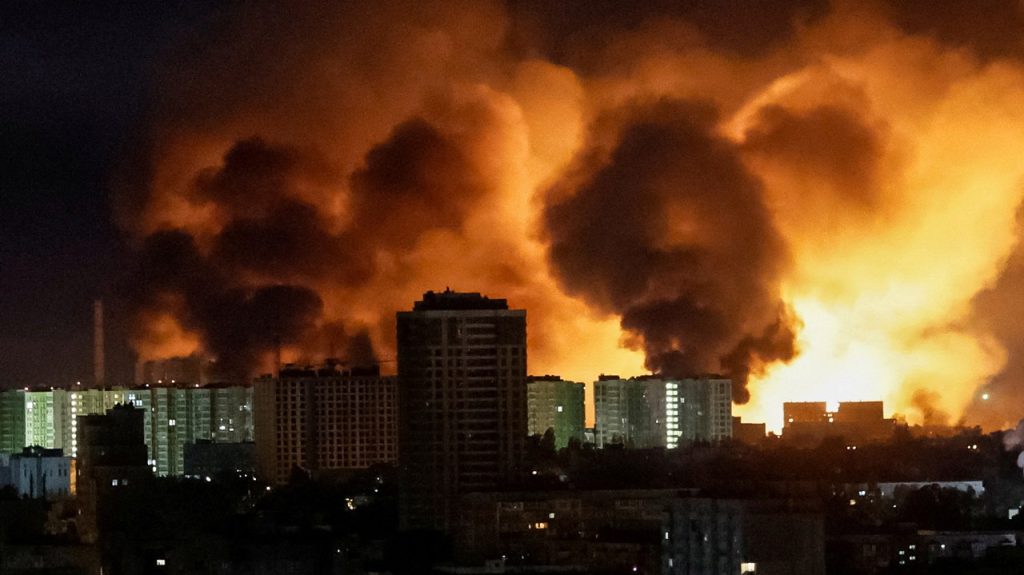In a significant escalation of hostilities, Russian forces launched an extensive aerial attack on Ukraine, which has been termed the largest offensive since the onset of the ongoing conflict. Over 367 drones and missiles struck various cities, including Kyiv, resulting in multiple casualties, with at least 12 confirmed dead and dozens more wounded. This assault highlights the continuing volatility in the region and raised serious concerns over international responses to Russia’s military actions.
| Article Subheadings |
|---|
| 1) Overview of the Attack |
| 2) Impact on Civilians |
| 3) International Response and Calls for Action |
| 4) Ceasefire and Negotiation Attempts |
| 5) Future Implications |
Overview of the Attack
The recent wave of aerial assaults initiated by Russian forces occurred overnight and represents a critical moment in the ongoing conflict between Ukraine and Russia. According to reports, the offensive involved a combination of 298 drones and 69 missiles aimed at various urban centers, including the capital city, Kyiv. This attack is significant not only for its scale, involving 367 total projectiles, but also for the coordination it demonstrated, given the rapid succession of strikes on multiple cities. The Ukrainian air force reported successfully intercepting a substantial number of these threats, claiming to have shot down 266 drones and 45 missiles, but the sheer volume of the attack still caused extensive destruction and casualties.
Impact on Civilians
The devastating impact of this attack has been felt acutely among civilians, with reports indicating at least 12 fatalities, including the tragic loss of three children in the northern region of Zhytomyr. Injuries have also been widespread, with at least 60 individuals reportedly hurt in various locations across the affected areas. In Kyiv, local officials confirmed that while no deaths were reported directly in the capital, surrounding regions suffered considerable violence, exacerbating the humanitarian crisis already experienced by many. Damage has not only been limited to infrastructure but has also deeply affected communities that grapple with the psychological scars of such brutal attacks.
International Response and Calls for Action
In the wake of the aerial assault, Ukrainian President Volodymyr Zelenskyy has called for a stronger international response, particularly from the United States, accusing it of remaining silent amidst escalating aggression from Russia. He emphasized the need for vocal opposition to Russian actions, arguing that the lack of response could embolden Russian President Vladimir Putin to continue such violent campaigns. Reports also indicate that U.S. Special Envoy to Ukraine Keith Kellogg criticized the attacks as a violation of the 1977 Geneva Peace Protocols, underlining calls for an immediate ceasefire and sanctions against Russia. The attack has reignited discussions among Western nations on the efficacy of their support for Ukraine and how to better address these ongoing threats.
Ceasefire and Negotiation Attempts
Efforts to establish a ceasefire have been a contentious topic amidst the escalating conflict, with Ukraine and its European allies advocating for a 30-day pause in hostilities as a precursor to meaningful negotiations aimed at bringing the three-year conflict to a close. However, these attempts faced setbacks recently when discussions over imposing harsher sanctions on Moscow—an initiative strongly supported by Kyiv—were stalled. It remains unclear how both sides can reconcile their positions, especially in light of the intense military exchanges that continue to characterize the conflict.
Future Implications
This latest aerial strike indicates a troubling trajectory for the conflict in Ukraine, with indications that Russian military capabilities are being increasingly leveraged against civilian populations. Without effective international intervention, the potential for further violence appears looming, raising questions about the sustainability of Ukraine’s defense efforts. Furthermore, as both sides remain prepared for ongoing exchanges, the situation calls for concerted efforts to facilitate diplomatic dialogue and humanitarian assistance for those impacted by this brutal conflict.
| No. | Key Points |
|---|---|
| 1 | Russia launched its largest aerial attack on Ukraine, involving 367 drones and missiles. |
| 2 | At least 12 people were reported killed, including children, with scores more injured. |
| 3 | Ukrainian President Zelenskyy urged for more vocal international support against Russian aggression. |
| 4 | Calls for a ceasefire are ongoing, yet progress has been limited due to international diplomatic challenges. |
| 5 | The attack’s ramifications amplify concerns over civilian safety and the potential for prolonged conflict. |
Summary
The recent aerial assault on Ukraine represents a grave escalation in the ongoing conflict, leading to tragic civilian casualties and raising pressing questions around international responses and future implications. As the region witnesses such violence, the necessity for diplomatic efforts intensifies, prompting a re-examination of the roles that global powers play in resolving this humanitarian crisis. Without a united front against aggression, the potential for further devastation remains high.
Frequently Asked Questions
Question: What triggered the recent aerial attack by Russia on Ukraine?
The recent attack appears to be a response to ongoing military tensions between Ukraine and Russia, characterized by a series of aggressive maneuvers and a lack of effective ceasefire agreements.
Question: How has Ukraine’s government responded to the casualties from the aerial attack?
Ukrainian officials, including President Volodymyr Zelenskyy, have condemned the attack as a terrorist act and are calling for greater international vocal opposition against Russia.
Question: What are the prospects for a ceasefire following this attack?
Prospects for a ceasefire remain uncertain, as both sides continue to engage militarily, and previous attempts to broker peace have been met with challenges, especially with differing expectations and the recent escalations.
